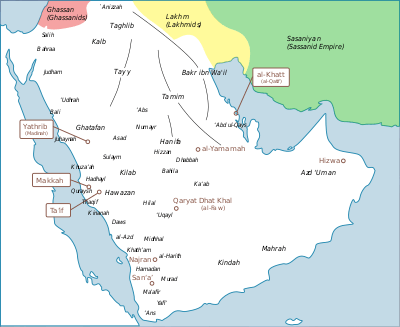Tribes of Arabia
The tribes of Arabia are the clans that originated in the Arabian Peninsula.
Much of the lineage provided before Ma'ad relies on biblical genealogy and therefore questions persist concerning the accuracy of this segment of Arab genealogy. The general consensus among 14th century Arabic genealogists is that Arabs are of three kinds:
Perishing Arabs (Arabic: العرب البائدة) are ancient tribes of whose history little is known. They include ‘Aad, Thamud, Tasm, Jadis, Imlaq and others. Jadis and Tasm perished because of genocide. 'Aad and Thamud perished because of their decadence, as recorded in the Qur'an. Archaeologists have recently uncovered inscriptions that contain references to 'Iram, which was a major city of the 'Aad. Imlaq is the singular form of 'Amaleeq and is probably synonymous to the biblical Amalek.
According to tradition, Pure Arabs (العرب العاربة) were from Yemen and were descendants of Ya‘rub bin Yashjub bin Qahtan who may have either been descended from Ishmael or from Eber. They were also called Qahtanite Arabs.[1][2]
According to tradition, Arabized Arabs (العرب المستعربة) originated from the progeny of Ishmael the first born son of the patriarch Abraham and the Jurhum tribe, also called ‘Adnani Arabs. Muhammad was an Adnanite Arab.
According to modern historians, the traditional distinction between Adnanites and Qahtanites lacks evidence and may have developed out of the later faction-fighting during the Umayyad period.[3]
List of tribes

Below is a partial list of the tribes of Arabia:
A
- Banu Abbas[4] (بنو عبّاس)
- Banu Amir
- Banu Abdul Qays (بنوعبدالقيس)
- Banu Abd-Shams (بنو عبد شمس)
- Banu Abs (بنو عبس)
- Banu Adi (بنو عدي)
- Banu Ajlan (بنو عجلان)
- Banu Aqeel (بنو عقيل)
Ali
- Ajman (tribe)
- ʿĀd (عاد)
- Bani Amir (بنو عامر)
- Banu Amr (بنو عمرو)
- AL-Subaie
- 'Anazah (عنزة)
- Banu Asad (بنو أسد)
- Banu Atiyah (بنو عطيّة)
- 'Asir (عسير)
- Banu Aus (بنو أوس)
- Al-Awazem (العوازم)in Kuwait
- Banu Awf (بنو عوف)
- Azd (الأزد)
B
- Al balawi(البلوي)
- Bariq
- Bali (tribe)
- Al-Baggara
- Bahila
- Banu Bahr
- Banu Bakr ibn Wa'il (بنو بكر بن وائل) from Rabi'ah branch of Adnanite tribes
- Banu Bakr ibn Abd Manat
- Balhareth
- Al Buainain
D
F
- Al-Farahidi
- Banu Fazara
- Banu Faham
G
- Al-Gain
- Ghamid
- Banu Ghaniya
- Banu Ghassan
- Ghatafan
- Banu Ghazan
- Banu Ghifar
- Bin Ghaith
- Banu Gashaam (ال قشعم)
H
- Hammyar iraq-Jabr Diab
- Hakami
- Humaydah
- Banu Hothail
- Bani Hamida
- Harb
- Banu Harith
- Banu Hashim
- Al-Hawajir Al-Hajri, Banu Hajr
- Banu Hilal
- Hakli (الحكلي)
J
- Al-Ja'aliyin (الجعليّين)
- Banu Jabar (بنو جبر)
- Al-Jiburi
- Banu Jalaf
- Al-Jaidi
- Al-Jiburi
- Banu Judham
- Banū Juhaynah (بنو جهينة)
- Banu Jumah
- Banu Jusham
K
- Banu Kaab
- Banu Kalb
- Banū Kanz
- Al-Karim
- Kendah
- Kathiri (الكثيري)
- Khawaja
- Khawlān (خولان)
- Banu Khutheer- a clan of Al Hajaj Tribe
- Banu Khuthayr- a branch of Qahtanites
- Bani Khalid (بنو خالد)
- Al-Khalifa (آل خليفة)
- Al-Khalili
- Al-Kharusi
- Banu Khash'am (بنو خثعم)
- Banu Khazraj (بنو خزرج)
- Banu Khuza'a (بنو خزاعة)
- Banu Kinanah (بنو كنانة)
L
M
- Al-Murrah
- Al-Maadeed
- Maqil ( المعقل)
- Al Mahri
- Mehri people
- El Mahroky
- Banu Makhzum
- Banu Malik
- Al Manaseer
- Banu Mustaliq
- Banu Mustafa
- Banu Muttalib
- Mutayr (مطير)
N
- Nabataeans
- Al Nuaim
- Al-Nabhani
- Banu Nadir
- Banu Najjar
- Banu Nawfal
- Al-Noman
Q
- Banu Qays
- Banu Qaynuqa (بنو قينقاع)
- Banu Quda'a (بنو قضاعة)
- Banu Qahtan
- Quraysh (قريش)
- Banu Qurayza (بنو قريظة)
- Qedarites
- qahtan (قحطان)
R
- Banu Rabi'ah
- Al Rashd (and they were living in liwa, AL-Khaznah and AL-Khatim with AL Awamr and AL MansoriAlRashdi)-(الراشدي)
- Bani Rasheed (the Rashaida people)
S
- alsharari الشراري
- Saba' سبأ
- Al-Saeed
- Banu Sa'ida
- Sayyid
- Shurman'
- Banu Sahm
- Banu Salama
- Irir Samali
- Al-Salti
- Shahrān (شهران)
- Al-Shabeeb
- Shammar
- Bani Shehr
- Shuraif
- Banu Shutayba
- Subay'
- Banu Sulaym
- Al-Suwaidi
T
- Banu Taym (بنو تيم, Quraysh sub-clan)
- Banu Taghlib (T. ibn Wā'il, بنو تغلب, branch of Rabī'ah)[4]
- Banu Tamim (بنو تميم)
- Thamud (ancient Arabs, ثمود)
- {[Al-tuhar]}الطوهر YEMEN
U
- Al-'Ubayd
- Banu Udhrah
- Banū Umayyah (بنو أميّة), famous in the western sources as the Umayyads.
- 'Utaybah (عتيبة)
- Bani Utbah (بنو عتبة)
Y
Z
- Zahran
- Banu Zahra
- Banu Zuhrah
- Banu Zayd
See also
References
- ↑ Reuven Firestone (1990). Journeys in Holy Lands: The Evolution of the Abraham-Ishmael Legends in Islamic Exegesis. p. 72.
- ↑ Göran Larsson (2003). Ibn García's Shuʻūbiyya Letter: Ethnic and Theological Tensions in Medieval al-Andalus. p. 170.
- ↑ Parolin, Gianluca P. (2009). Citizenship in the Arab World: Kin, Religion and Nation-State. p. 30. ISBN 978-9089640451. "The ‘arabicised or arabicising Arabs’, on the contrary, are believed to be the descendants of Ishmael through Adnan, but in this case the genealogy does not match the Biblical line exactly. The label ‘arabicised’ is due to the belief that Ishmael spoke Hebrew until he got to Mecca, where he married a Yemeni woman and learnt Arabic. Both genealogical lines go back to Sem, son of Noah, but only Adnanites can claim Abraham as their ascendant, and the lineage of Mohammed, the Seal of Prophets (khatim al-anbiya'), can therefore be traced back to Abraham. Contemporary historiography unveiled the lack of inner coherence of this genealogical system and demonstrated that it finds insufficient matching evidence; the distinction between Qahtanites and Adnanites is even believed to be a product of the Umayyad Age, when the war of factions (al-niza al-hizbi) was raging in the young Islamic Empire."
- 1 2 3 http://us.geocities.com/agecroft_79/materials/klynstra.htm